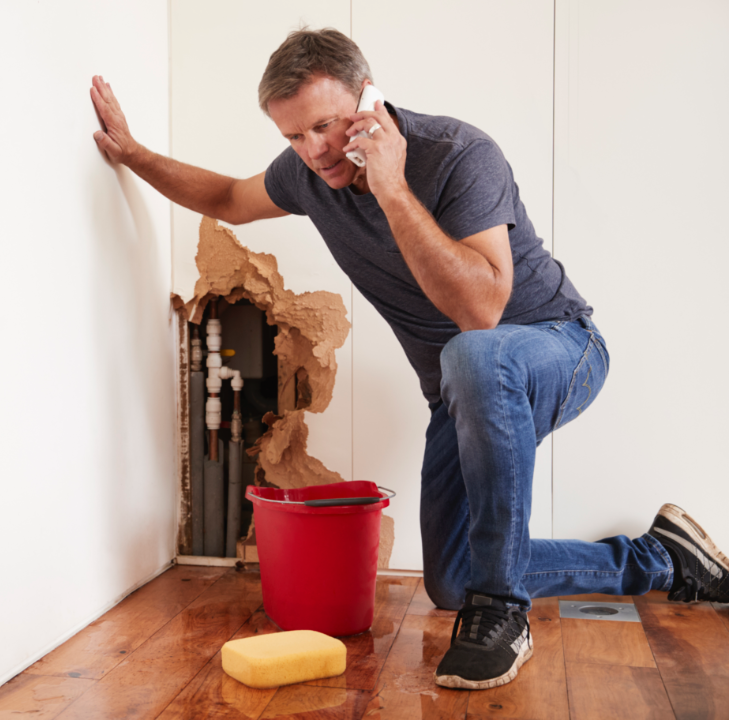As the outside temperatures drop rapidly below the freezing mark, the water inside your home's pipes can freeze and expand. However, the exact temperature at which pipes burst can vary.
Most pipes risk bursting when outdoor temperatures drop below 20° Fahrenheit (F) or -6° Celsius (C). Although an important guideline, this is not an absolute threshold. Pipes in unheated areas or near exterior walls or crawl spaces may be more susceptible to freezing and bursting.
Science Behind Pipe Bursts
When temperatures drop below freezing, the risk of pipe bursts increases significantly. However, understanding the science behind the phenomenon can help homeowners and property managers take preventive measures to avoid costly damage.
The leading cause of pipe bursts in cold weather is expansion. As water freezes, it undergoes a unique transformation. Unlike other substances, water expands when it freezes due to the formation of ice crystals. That expansion puts immense pressure on the walls of the pipes, leading to cracks or even complete ruptures.
Another factor contributing to pipes bursting is thermal contraction. When exposed to cold temperatures, pipe material can contract or shrink and become more brittle. That makes them more susceptible to cracking or breaking under stress.
Allowing faucets to drip slightly can also relieve pressure build-up within the pipes. It's best to contact a plumbing professional for assistance if you suspect your pipes are frozen or at risk of bursting.
Factors Affecting the Bursting Point of Pipes
Several factors contribute to a pipe bursting, including:
- Pipe Material
- Lack of Pipe Insulation
- Duration of Exposure to Freezing Temperatures
- Pipe Diameter
- Water Pressure
Pipe Material
Firstly, the choice of pipe material is crucial in determining its bursting point. Varying materials have different levels of strength and durability.
For example, copper pipes are known for their high corrosion resistance and can withstand higher pressures than plastic pipes. These pipes can withstand freezing temperatures as low as -20℉ (-6℃) without significant risk of bursting or cracking. The same is also true for many other types of pipe material, including:
- Polyvinyl Chloride, or PVC pipes
- Galvanized Steel Pipes, commonly used outdoors
- High-Density Polybutylene, or HDPE, commonly used in undergound service line in municipal infrastructure
Lack of Pipe Insulation
Secondly, pipe insulation can affect the bursting point. Insulation helps regulate temperature changes in the surrounding environment and prevents freezing or overheating. Proper insulation can reduce stress on the pipes and minimize the risk of bursting due to extreme temperature fluctuations.
Duration of Exposure to Freezing Temperatures
The duration of exposure to freezing temperatures is essential for determining the risk of pipes bursting. When water inside a pipe freezes, it begins to expand, putting pressure on the walls of the pipes. If this pressure gets too high, it the pipe could burst, leading to costly repairs and potential water damage.
The exact duration required for pipes to freeze depends on factors already discussed:
- Temperature Outside
- Pipe Material
- Insulation of the Pipes
- Location Within a Building or Underground
Generally, prolonged exposure to temperatures below 32℉ (0℃) increases the likelihood of pipe freezing. It is important to remember not all pipes are equally susceptible to freezing. The most vulnerable pipes are in unheated and uninsulated areas in a home or office building, such as:
- Basements
- Mezzanines
- Attics
- Crawl Spaces
- Exterior Walls
Pipe Diameter
The diameter of a pipe also impacts its bursting point. Generally, larger-diameter pipes have a higher capacity to handle more significant water pressure without rupturing. Smaller diameter pipes may be more susceptible to bursting if subjected to excessive pressure.
Water Pressure
Lastly, water pressure is a critical factor affecting pipe integrity. Higher water pressure exerts more force on the walls of the pipe, increasing the likelihood of it reaching its bursting point. It is essential that water pressure remains within safe limits specified by plumbing codes and regulations.
Understanding these factors is crucial for designing plumbing systems to withstand normal operating conditions without compromising safety or risking costly damages caused by burst pipes.
Preventing Pipe Bursts: Tips for Cold Weather Protection
Preventing pipe bursts during cold weather is crucial to avoid costly damages and inconveniences. Winterizing pipes with proper insulation can protect your home's plumbing system from freezing temperatures. Maintaining an adequate indoor temperature can also help prevent pipes from freezing and bursting.
To winterize your pipes:
- Start by disconnecting outdoor hoses and drain remaining water from the hoses.
- Turn off the water supply to an outdoor faucet.
- Wrap exposed pipes with foam pipe insulation or heat tape.
Keep the temperature above freezing inside your home, even when you're away. Increase your thermostat to a minimum of 72℉ (22℃) to maintain a warm enough environment for the pipes.
In addition, leave cabinet doors under sinks open so warm air can circulate around those pipes. Regularly inspecting your plumbing system for leaks or cracks is also important. Even small leaks lead to frozen pipes if left unfixed.
What to Do If Your Pipes Burst: Emergency Steps and Damage Control
When faced with the unfortunate situation of burst pipes, it is crucial to act quickly and take the necessary steps to minimize damage. Following emergency procedures and implementing effective damage control measures can mitigate the impact of a pipe burst in your home or property.
- Shut off the main water supply valve immediately.
- Assess and document damage caused by flooding.
- Remove excess water from affected areas.
- Turn off the electricity if necessary.
- Contact a professional plumber for repairs.
Taking prompt action can help minimize further damage and guarantee a swift recovery from an unfortunate plumbing event. Contact the plumbing experts in Lamar, Missouri, Clements Plumbing Heating & Air by calling 417-682-3797.
